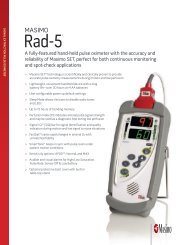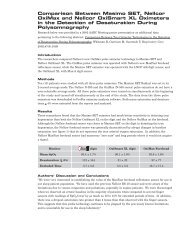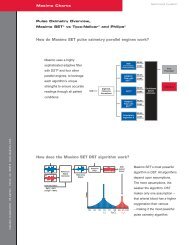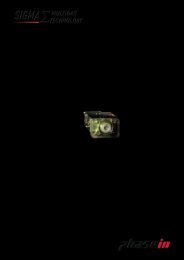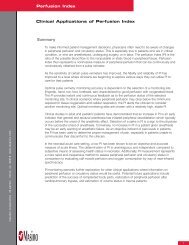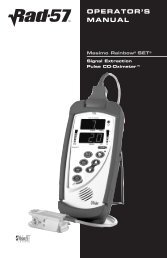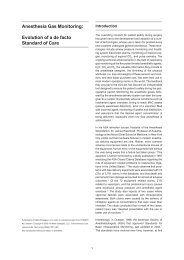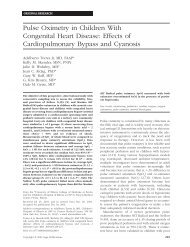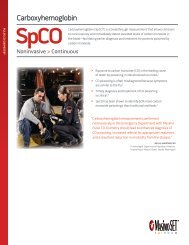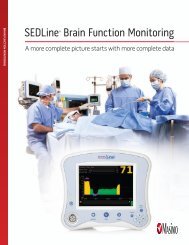Datex-Ohmeda Whitepaper - Masimo
Datex-Ohmeda Whitepaper - Masimo
Datex-Ohmeda Whitepaper - Masimo
You also want an ePaper? Increase the reach of your titles
YUMPU automatically turns print PDFs into web optimized ePapers that Google loves.
<strong>Datex</strong>-<strong>Ohmeda</strong> Signals<br />
<strong>Datex</strong>-<strong>Ohmeda</strong> Pulse Oximetry Analysis<br />
This document is in response to the <strong>Datex</strong>-<strong>Ohmeda</strong> white paper found on their website. The white<br />
paper is entitled "<strong>Datex</strong>-<strong>Ohmeda</strong> TruTrak+ Pulse Oximetry Technology; A 350 Patient, Multi-Site<br />
Performance Evaluation During Clinical Motion." In this white paper, <strong>Datex</strong>-<strong>Ohmeda</strong> (D-O) discusses<br />
a 350-patient study that was used to determine the magnitude, duration and characteristics of patient<br />
motion. They include descriptions of the tests (clinical and in-house) they used to validate changes<br />
made to their algorithm(s).<br />
This response will be in 4 parts: 1) a discussion of the paper describing data collection on 350 patients<br />
during clinical motion; 2) a discussion of the tests run on their new system (TruTrak+); 3) current<br />
information concerning TruTrak+ as implemented in the <strong>Datex</strong>-<strong>Ohmeda</strong> 3900; and 4) a recent motion<br />
study performed by Dr. Steven Barker, Chief of Anesthesiology at the University of Arizona, during<br />
volunteer motions.<br />
1. A Discussion of the <strong>Datex</strong>-<strong>Ohmeda</strong> White Paper entitled,<br />
"A Characterization of Motion Affecting 350 Patients"<br />
- In their paper "A Characterization of Motion Affecting 350 Patients," the authors (all employees<br />
of <strong>Datex</strong>-<strong>Ohmeda</strong> at the time of the study) attempt to describe patient motion. However, the title<br />
of their paper is misleading in that 280 patients they analyzed were not moving during the<br />
observation. In addition, of the 70 patients that did move, they only collected data on 35<br />
patients. These 35 patients were monitored with pulse oximetry and an accelerometer for<br />
approximately 25 minutes each. The total monitoring time was approximately 14.5 hours for the<br />
studied patients (the entire 350 patient study). From this amount of data they attempt to<br />
categorize motion to help them develop better algorithms to deal with that problem. 1<br />
masimo corporation 40 parker irvine ca 92618 www.masimo.com<br />
In their paper, the authors attempt to categorize most motions as being of short duration, with<br />
62% of the motions lasting 10 seconds or less. They do have one case where the motion was<br />
continuous for 92 seconds. But what is misleading is the absence of one important piece of<br />
information: what type of motion caused conventional pulse oximeters to give inaccurate<br />
measurements and false alarms. After all, that’s what “Next Generation” pulse oximeters are<br />
supposed to solve. All in all, the paper is misleading due to the lack of sufficient quantity of<br />
challenging clinical data.<br />
2. The Tests Run On the New <strong>Datex</strong>-<strong>Ohmeda</strong> TruTrak+ System<br />
- The bulk of the paper attempts to validate their new algorithm(s) in the clinical environment<br />
against conventional pulse oximeters as well as <strong>Masimo</strong> pulse oximeters. In the clinical data<br />
presented there is no control or "gold standard," such as blood gases. Nor did they attempt an<br />
analysis like "Silver Standard Analysis" (See <strong>Masimo</strong> Silver Standard Analysis Technical<br />
Bulletin.) They rely only on clinical impressions, which may or may not be accurate. Indeed, D-<br />
O shows a figure in which the <strong>Masimo</strong> pulse oximeter is supposedly "freezing" while the<br />
TruTrak+ is catching a desaturation. This may, in fact, be a false desaturation caused by the<br />
inability of TruTrak+ to handle the motion. Without the use of a control of some nature (for<br />
example, Silver Standard Analysis) you can only guess which oximeter is right. The authors give<br />
themselves the benefit of the doubt. It is important to note that the ECRI report showed<br />
<strong>Masimo</strong> as the only next generation oximeter that did not exhibit any freezing. Overall the<br />
<strong>Datex</strong>-<strong>Ohmeda</strong> authors indicate that the TruTrak+ is better than conventional pulse oximetry<br />
and compares "favorably" to the <strong>Masimo</strong> technology.<br />
1 of 2
<strong>Datex</strong>-<strong>Ohmeda</strong> Signals<br />
<strong>Datex</strong>-<strong>Ohmeda</strong> TruTrak+ Pulse Oximetry Technology<br />
3. Current Information Concerning Tru-Trak+ as Implemented<br />
in the <strong>Datex</strong>-<strong>Ohmeda</strong> 3900<br />
- It is interesting to note that D-O claims TruTrak+ only "works" in their longest averaging mode. If<br />
you move the D-O 3900 out of the default 12 second average into the 3 or 6 second average,<br />
the message "TruTrak+ Off" is displayed. In other words, in the longest average (which slows<br />
changes and decreases false alarms anyway) TruTrak+ is working, while in the shorter<br />
averages it is not active. In clinical practice, Sleep Disordered-Breathing testing should be done<br />
in the shortest average available. Many anesthesiologists and neonatologists want the pulse<br />
oximeter to be in a short average (fast response) during intubation and resuscitation.<br />
4. A Recent Motion Study by Dr. Steven Barker During Volunteer<br />
Motions<br />
masimo corporation 40 parker irvine ca 92618 www.masimo.com<br />
- In the October 2004 edition of Anesthesia and Analgesia, Steven J. Barker, MD, PhD, Chairman<br />
of the Department of Anesthesia of the University of Arizona and invited ASA speaker on the<br />
topic of Oxygen Monitoring, and a team of researchers presented data on the latest generation<br />
pulse oximeter models from leading manufacturers, including <strong>Masimo</strong>. The researchers<br />
compared the read-though motion and low perfusion capability of five "Next Generation" pulse<br />
oximeters set in their shortest averaging times while rapidly changing the oxygenation of adult<br />
subjects. Dr. Barker found that the <strong>Masimo</strong> Radical, even in its shortest averaging mode,<br />
closely corroborated the <strong>Masimo</strong> SET Radical in its 8-second average (as determined in their<br />
previous studies.) The other "motions resistant" pulse oximeters showed decreased sensitivity<br />
and specificity compared to the <strong>Masimo</strong> SET Radical. In particular, the <strong>Datex</strong>-<strong>Ohmeda</strong> showed<br />
the lowest sensitivity (ability to track true events) when compared to all the other pulse<br />
oximeters. 2 With the laboratory room chilled to 16-18 o C, the volunteers were subjected to<br />
various motions produced by a motion table, which delivered random and periodic motions. Dr.<br />
Barker found the <strong>Masimo</strong> SET Radical, even in its shortest averaging mode, closely<br />
corroborated the <strong>Masimo</strong> SET Radical in its 8-second average (as determined in their previous<br />
studies). The other "motion resistant" pulse oximeters showed decreased sensitivity and<br />
specificity compared to the <strong>Masimo</strong> Radical.<br />
References<br />
Pulse Oximeter<br />
Missed<br />
Events<br />
Sensitivity<br />
Specificity<br />
False<br />
Alarms<br />
Averaging<br />
Time (sec)<br />
<strong>Masimo</strong> Radical (V 4) 1 99% 97% 4 2<br />
Nellcor N-595 (v 3000) 15 63% 73% 16 2<br />
MARS (v2001) 15 63% 50% 30 2<br />
<strong>Datex</strong> <strong>Ohmeda</strong> 3900 (v9/11) 16 63% 88% 7 3<br />
Philips Viridia (v9/11) 9 78% 82% 11 5<br />
1. Editorial Note: 14.5 hours of data may be an insufficient amount to categorize the types of motions and duration of motion in all clinical<br />
environments. In contrast, <strong>Masimo</strong> has thousands of hours of data collected on many patients in numerous clinical areas and in<br />
multiple types of clinical conditions during motion, low perfusion and other challenging conditions.<br />
2. Barker SJ, Morgan S. A Laboratory Comparison of the Newest "Motion-Resistant" Pulse Oximeters During Motion and Hypoxemia.<br />
Anesth & Analg 2004;98(5S):S2.<br />
7378-3585A-1104<br />
2 of 2




